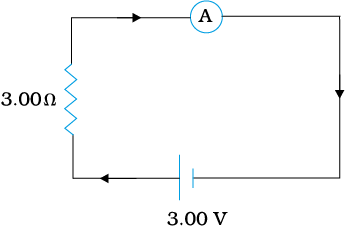In the circuit (shown in the figure) the current is to be measured. What is the value of the current if the ammeter shown is a galvanometer but converted to an ammeter by a shunt resistance ?


A solenoid has a core of material with relative permeability \(400.\) The windings of the solenoid are insulated from the core and carry a current of \(2~\text{A}.\) If the number of turns is \(1000\) per metre, the magnetizing current \(I_m\) is:
1. \(746~\text{A}\)
2. \(700~\text{A}\)
3. \(729~\text{A}\)
4. \(794~\text{A}\)
The SI unit of magnetic field intensity is
1.
2.
3.
4.
A thick current-carrying cable of radius '\(R\)' carries current \('I'\) uniformly distributed across its cross-section. The variation of magnetic field \(B(r)\) due to the cable with the distance '\(r\)' from the axis of the cable is represented by:
| 1. |  |
2. |  |
| 3. |  |
4. |  |
An infinitely long straight conductor carries a current of \(5~\text{A}\) as shown. An electron is moving with a speed of \(10^5~\text{m/s}\) parallel to the conductor. The perpendicular distance between the electron and the conductor is \(20~\text{cm}\) at an instant. Calculate the magnitude of the force experienced by the electron at that instant.
1. \(4\pi\times 10^{-20}~\text{N}\)
2. \(8\times 10^{-20}~\text{N}\)
3. \(4\times 10^{-20}~\text{N}\)
4. \(8\pi\times 10^{-20}~\text{N}\)
A uniform conducting wire of length \(12a\) and resistance '\(R\)' is wound up as a current-carrying coil in the shape of;
| (i) | an equilateral triangle of side '\(a\)' |
| (ii) | a square of side '\(a\)' |
The magnetic dipole moments of the coil in each case respectively are:
1. \(3Ia^2~\text{and}~4Ia^2\)
2. \(4Ia^2~\text{and}~3Ia^2\)
3. \(\sqrt{3}Ia^2~\text{and}~3Ia^2\)
4. \(3Ia^2~\text{and}~Ia^2\)
In the product
\(\vec{F}=q\left ( \vec{v}\times \vec{B} \right )\)
\(~~~=q\vec{v}\times \left ( B\hat{i}+B\hat{j}+B_0\hat{k} \right )\)
For \(q=1\) and \(\vec{v}=2\hat{i}+4\hat{j}+6\hat{k}\)
and \(\vec{F}=4\hat{i}-20\hat{j}+12\hat{k}\)
What will be the complete expression for \(\vec{B}\)?
1. \(8\hat{i}+8\hat{j}-6\hat{k}\)
2. \(6\hat{i}+6\hat{j}-8\hat{k}\)
3. \(-8\hat{i}-8\hat{j}-6\hat{k}\)
4. \(-6\hat{i}-6\hat{j}-8\hat{k}\)
For the circuit (shown in the figure), the current is to be measured. The ammeter shown is a galvanometer with a resistance . The value of current is:

1. 0.004 A
2. 0.032 A
3. 0.222 A
4. 0.048 A
Which one of the following statements is incorrect?
| 1. | A current-carrying circular loop lies on a smooth horizontal plane. A uniform magnetic field can be set up in such a manner that the loop turns around itself (i.e., turns about the vertical axis). |
| 2. | A current-carrying circular loop is located in a uniform external magnetic field. If the loop is free to turn, the orientation of stable equilibrium is one where the area vector A of the loop is in the direction of the external magnetic field. |
| 3. | A loop of irregular shape carrying current is located in an external magnetic field. If the wire is flexible, it changes to a circular shape. |
| 4. | None of these. |
A 100 turn closely wound circular coil of radius 10 cm carries a current of 3.2 A. What is the angular speed acquired by the coil when it has rotated by 90° under the influence of a magnetic field of magnitude 2T that is applied along the axis of the coil? The moment of inertia of the coil is 0.1 kg-.







